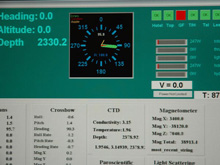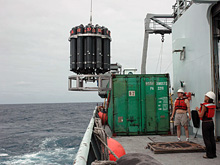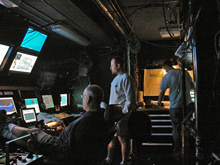
At 11:00am, a red warning appears on the DSL topside GUI monitor, alerting technicians of a "ground" or power failure in the system. Unable to isolate the problem from the surface, the DSL must be brought up for analysis. Click image for larger view and image credit.
Sonar Troubles
December 6, 2005
William Sellers
DSL Expedition Leader
The DSL120 sonar sled is 2300 meters deep beneath the Pacific collecting data with a variety of sensors transmitted via fiber optic cable to the ship. Technicians and scientists monitor incoming data in the DSL van, while others check monitors in the hydro and main lab. At 11:00 am, a red warning appears on the DSL topside GUI monitor; I receive a call from DSL Technician, Bob Waters. “We have a hard ground on the high voltage side of the 120.” Knowing we have no way of isolating the problem in the control van, we decide to err on the side of caution and bring the DSL sonar sled to the surface.
A ground occurs when one side of the power, positive or negative, is connected to seawater and shorts out. This can happen due to many circumstances, the most common being water in a connector. At a depth of 2300 meters, it takes 2 hours to bring the sonar to the surface for recovery. Once on deck, we begin troubleshooting the problem.

During scientific cruises, time is precious. In order to maximize science time while the DSL undergoes repairs, the CTD and Niskin bottles are lowered over previously identified hydrothermal plume sites to collect additional data. Click image for larger view and image credit.
The first step to finding the ground is to verify it is still there. They often disappear when the vehicle is removed from saltwater, making the problem tough to pin point. Fortunately, this time the ground is still there, so the next step is to look for water entry in junction boxes and connectors. Not finding a “smoking gun,” we pull the electronics chassis out of its housing and bring it inside for further investigation.
During scientific cruises, time is very precious. The DSL sled was lowered last night at 10:04 pm to begin surveying. During the 14-hour deployment, sensors collected data and 3 hydrothermal vents were detected by the system. In order to maximize science time, the scientists decide to deploy the CTD and Niskin bottles over the identified plume sites to collect data while the sonar electronics undergo repairs. Samples and data collected by the bottles and CTD sensors include pH, helium concentrations, particles, dissolved metals, and dissolved methane. The chemistry of the fluids coming out of the hydrothermal vents provide clues that are crucial to understanding the hydrothermal system.

DSL technicians and scientists monitor incoming data and information from the sonar sled in the DSL van. Data from the DSL120 and attached sensors are transmitted real-time through fiber optic cable to systems on board the R/V Thompson. Click image for larger view and image credit.
While the plume sampling team gathers data, electrical engineers go to work inside the lab and succeed in identifying the DSL120 problem; it is attributed to a design flaw in the sonar system. The sonar system and the telemetry (communication) system are in the same chassis, each with its own power supply, but for electronic noise purposes they share a common ground. This gave the ground fault detection circuit a false indication. We are able to disable the detector for this one particular circuit, leaving the ground fault detector to monitor the rest of the system. The problem is solved, and we go to work reassembling the sonar sled.
Fast Fact
Did you know that sound travels approximately four times faster in water than it does in air?
Sign up for the Ocean Explorer E-mail Update List.




























